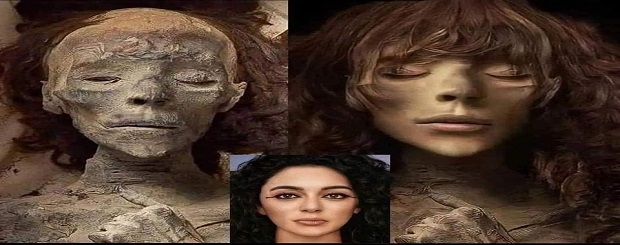
King Tutankhamun’s DNA belonged to R1b with the said origin in South Caucasus – The main haplogroup of Armenians is R1b and the oldest is in Armenians
JULY 28, 2022 – Ararat Place O fCreation – History Museum
RECONSTRUCTIONS SHOW TYPICAL ARMENIAN WOMAN.
King Tutankhamun’s DNA belonged to R1b with the said origin in South Caucasus. The main haplogroup of Armenians is R1b and the oldest is in Armenians. This reconstruction looks typical Armenian woman, both with complexion and facial features. It confirms the theory of the Father of Egyptian Archaeology William Matthew Flinders Petrie who noted that Mitanni was an Armenian Kingdom and Queen Thiy, (mother of Akhenaten, mother in law to another future Egyptian queen of Armenian Mitannian origin Nefertiti and grandmother of Tutankhamun) was an Armenian.
Scientists at Zurich-based DNA genealogy centre, iGENEA, reconstructed the DNA profile of the boy Pharaoh, who ascended the throne at the age of nine, his father Akhenaten and grandfather Amenhotep III.
The results showed that King Tut belonged to a genetic profile group known as haplogroup R1b.
Among modern-day Egyptians this haplogroup contingent is below 1 percent, according to iGENEA.
“We think the common ancestor ( with Western Europeans) lived in the Caucasus about 9,500 years ago,” Scholz told Reuters.
It is estimated that the earliest migration of haplogroup R1b into Europe began with the spread of agriculture in 7,000 BC, according to iGENEA.
Previously R1b was called:
R1b = Italic, Celtic, Germanic/ Hittite, Armenian
Now it is called:
R1b: Italo/Celtic, Germanic; Hittite, Armenian, Tocharian
Haplogroup R1b (Y-DNA) is the dominant paternal lineage of Western Europeans. It is also a dominant haplogroup of Armenians.
Eu18 or R1b has its maximal concentration in Ireland and Pyrenees (Basques) up to 90% population, being widespread in Western Europe and gradually rarer eastwards, reaching up to Armenia in lower rate.
In Armenians R1b has been estimated to be 8,000 years old. The closer we get to NW Europe, the more we observe the youngest, derived forms of R1b.
A study published in August 2010 (Myres et al.) says : “The phylogenetic relationships of numerous branches within the core Y-chromosome haplogroup R-M207 support an Armenian Highland (wrong usage of West Asian in original quote) origin of haplogroup R1b, its initial differentiation there followed by a rapid spread of one of its sub-clades carrying the M269 mutation to Europe.”
Result of the over 300 individuals that have already been tested revealed that the Armenian branches of DNA are at the root of many branches in Europe. Armenians belong to 13 distinct genetic groups that go back tens of thousands of years, while at the same time there is no trace of invaders in their DNA in the last 4000 years, making them “homogeneous in their diversity”.
Although it is rare in South Asia, some populations show relatively high percentages for the haplogroup R1b. These include the Lambadi (Andhra Pradesh) showing 37%, Hazara 32% and Agharia (East India) at 30%.

